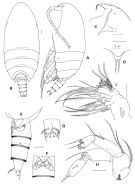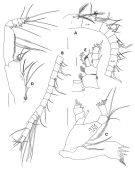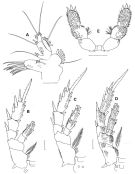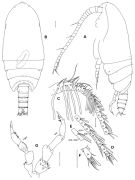|
|
 |
Fiche d'espèce de Copépode |
|
|
Calanoida ( Ordre ) |
|
|
|
Clausocalanoidea ( Superfamille ) |
|
|
|
Scolecitrichidae ( Famille ) |
|
|
|
Xantharus ( Genre ) |
|
|
| |
Xantharus siedleckii Schulz & Kwasniewski, 2004 (F) | |
| | | | | | | Ref.: | | | Schulz & Kwasniewski, 2004 (p.151, figs.F, Rem: p.156-158); Bradford-Grieve, 2005 (p.947, tab.1: morphological remarks) |  issued from : K. Schulz & S. Kwasniewski in Sarsia, 2004, 89. [p.153, Fig.6]. Female (from Spitzbergen): A, habitus (lateral left side); B, idem (dorsal); C, forehead (lateral); D, rostrum (anteroventral view); E, urosome (lateral left side); F, genital segment (double somite) (ventral); G, caudal rami (ventral); H, A2; I, Mx2. Scale lines 0.05 mm. Nota : Rostrum strong , directed ventrally, bearing pair of slender filaments. - A2 : exopod slightly longer than endopod. Coxa with patch of long spinules along outer margin and 1 long inner seta ; basis with 2 unequal inner setae ; endopod 2-segmented ; exopod indistinctly 8-segmented, setal formula 0, 1, 1, 1, 1, 1, 1, 3. - Mx2 : proximal praecoxal endite with 4 setae ; distal praecoxal and both coxal endites each with 3 setae, one of them shorter ; basal endite carrying 1 stout spine, 1 strong curved seta plus 2 selender setae. Endopod indistinctly 3-segmented, armed with 5 subequal brush-like sensory setae having small compact heads, and 3 long worm-like sensory setae. - 1st pedigerous somite integrated into cephalosome ; 4th and 5th pedigerous somites separate except ventrolaterally. - Sensillae distributed on prosomal somites as figured. - Urosome 4-segmented. - Genital double-somite symmetrical (in dorsal aspect), weakly roduced ventrally ; seminal receptacles comparatively large, bean-shaped. - Urosomal somites 1-3 with dentate hyaline frill on posterior margin ; somite 3 longer than 2 ; anal somite very short, about 10% length of preceding somite and completely concealed beneath its hyaline frill. - Caudal rami symmetrical, longer than wide ; armature consisting of 6 setae ; seta II reduced, implanted on lateral edge ; setae III-VI strong, implanted distally ; seta VII reduced, displaced ventrally.
|
 issued from : K. Schulz & S. Kwasniewski in Sarsia, 2004, 89. [p.154, Fig.7]. Female: A, A1 (segments I-XIII), idem (segments XIV-XXVIII); C, Md; D, Mxp; E, P1. Scale lines 0.05 mm. Nota :
A1 symmetrical, short, 24-segmented ; compound segments involving ancestral segments II-IV, X-XI and XXVII-XXVIII
|
 issued from : K. Schulz & S. Kwasniewski in Sarsia, 2004, 89. [p.155, Fig.8]. Female: A, Mx1; B, P2; C, P3; D, P4; E, P5. Scale lines 0.05 mm. Nota : Mx1 : praecoxal arthrite with 9 marginal and 3 posterior setae ; coxal epipodite with row of 9 setae ; coxal endite with 2 setae ; basal endites with 4 setae each ; exopod with 8 marginal setae ; endopod uncegmented, armed with 3 + 2 + 5 setae. Praecoxal arthrite, basis and exopod ornamented with denticles as figured. P5 : uniramous, symmetrical, 3-segmented, with proximal segment separate from intercoxal sclerite ; distal segment mostly fused to second, bearing 2 short spine-like projections distally and 1 short inner spine subdistally, all covered with denticles ; length of segments increasing from 1st to 3rd, and ornamented with denticles ; inner margin of 2nd segment bearing long spinules.
|
 issued from : K. Schulz & S. Kwasniewski in Sarsia, 2004, 89. [p.157, Fig.9]. Male: A, habitus (lateral left side); B, idem (dorsal); C-F, A1; G, P5 (posterior). Scale lines 0.05 mm. Nota : A1 slightly asymmetrical, extending to end of 2nd pedigerous somite. Segmentation pattern as in female except for right A1, 23-segmented due to fusion of ancestral segments XXII-XXIII ; armature differing from female especially in the presence of a higher number of aesthetascs, with double aesthetascs located on segments III, V, VII, IX, and XI. P5 asymmetrical, uniramous ; left longer than right. Coxa of right leg fused with intercoxal sclerite ; left ramus indistinctly 5-segmented ; coxa larger than right counterpart, with sparsely set long spinules distally ; basis with lobe-like protrusion distally on inner margin (interpreted as remnant of endopod) ; exopod slender, 1st segment armed with small inner and slightly larger spine distolaterally ; 2nd segment having short inner row of spinules distally ; 3rd segment tapering distally, about half length of preceding segment and incompletely separated from it, with a row of spinules on inner margin. Right ramus 5-segmented, coxa and basis of about equal size, coxa ornamented with distolateral spinules ; basis unarmed, with distomedial outgrowth (probably remnant of endopod) ; exopod shorter than left counterpart, 1st segment with small spine on distolateral edge and spinules as figured ; 2nd segment having a row of spinules on inner face ; terminal segment more slender, spine-like, tapering distally and armed with small, spine-like projection on outer half. Urosome 5-segmented. Genital somite asymmetrical, slightly produced posteriorly on left side ; gonopore opening posterolaterally on left side. Anal somite extremely short.
| | | | | Ref. compl.: | | | Hop & al., 2006 (p.182, Table 4); | | | | NZ: | 1 | | |
|
Carte de distribution de Xantharus siedleckii par zones géographiques
|
| | | | Loc: | | | Arctic: Spitsbergen (Kongsfjorden) | | | | N: | 2 | | | | Lg.: | | | (886) F: 1,2-1,54; {F: 1,20-1,54} | | | | Rem.: | Fonds: 360-330 m.
Voir aussi les remarques en anglais | | | Dernière mise à jour : 28/03/2016 | |
|
|
 Toute utilisation de ce site pour une publication sera mentionnée avec la référence suivante : Toute utilisation de ce site pour une publication sera mentionnée avec la référence suivante :
Razouls C., Desreumaux N., Kouwenberg J. et de Bovée F., 2005-2025. - Biodiversité des Copépodes planctoniques marins (morphologie, répartition géographique et données biologiques). Sorbonne Université, CNRS. Disponible sur http://copepodes.obs-banyuls.fr [Accédé le 16 novembre 2025] © copyright 2005-2025 Sorbonne Université, CNRS
|
|
 |
 |







